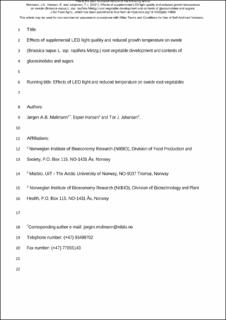Effects of supplemental LED light quality and reduced growth temperature on swede (Brassica napus L. ssp. rapifera Metzg.) root vegetable development and contents of glucosinolates and sugars
Peer reviewed, Journal article
Accepted version
Permanent lenke
https://hdl.handle.net/11250/2725191Utgivelsesdato
2020-10-04Metadata
Vis full innførselSamlinger
Sammendrag
BACKGROUND Low growth temperatures and the special light qualities of midnight sun in northern Scandinavia, have both been shown to improve eating quality of swede root bulbs. To study the combined effect of these factors on root development and sensory‐related compounds, plants were grown in phytotron under different 24 h supplemental light‐emitting diode (LED) light colours, at constant 15 °C, or reduced end‐of‐season temperature at 9 °C. RESULTS Far‐red LED (740 nm) light induced longer leaves and produced more roundly shaped bulbs, than the other light quality treatments. At constant 15 °C, supplemental light of far‐red LED also produced a stronger purple crown skin colour than the other LED treatments. This difference between light quality treatments disappeared at 9 °C, as all bulb crowns developed a purple colour. There were no significant effects of LED‐supplements on sugar concentrations, while the reduced temperature on average did increase concentrations of d‐fructose and d‐glucose. Total glucosinolate concentrations were not different among treatments, although the most abundant glucosinolate, progoitrin, on average was present in highest concentration under LEDs containing far‐red light, and in lower concentration at 9 °C compared to 15 °C. CONCLUSION The light quality of 24 h photoperiods in combination with temperature appears primarily important for growth and morphological traits in swede root bulbs. Influence of light quality and low temperature on appearance and sensory‐related compounds may be utilized in marketing of root vegetables with special quality related to growth conditions of high latitude origin. © 2020 Society of Chemical Industry
